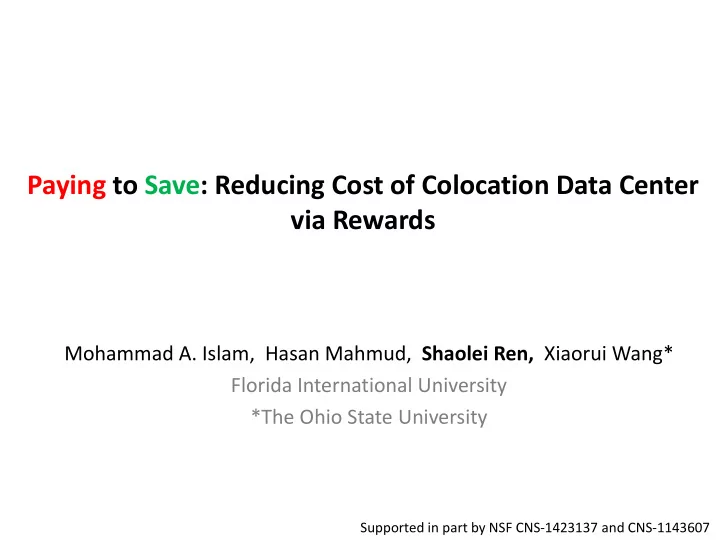

Paying to Save: Reducing Cost of Colocation Data Center via Rewards Mohammad A. Islam, Hasan Mahmud, Shaolei Ren, Xiaorui Wang* Florida International University *The Ohio State University Supported in part by NSF CNS-1423137 and CNS-1143607
Data center Google's data center in Mayes County, Oklahoma 2
Data centers are power -hungry 91 billion kWh; 50% increase by 2020 Power entire Washington; $10+ billion U.S. data centers in 2013 Workload 0 12 24 36 48 Time Many energy-saving techniques 3 Source: Natural Resources Defense Council
Bad news… Most of the existing approaches cannot be applied in many large data centers… 4
What are data centers? 5
What are data centers? Data centers 6
Multi-tenant colocation data center • Multiple tenants house their own servers in one shared space and manage their equipment independently • Data center operator is mainly responsible for facility management (e.g., power distribution, cooling) CoreSite’s “One Wilshire” (Photo: CoreSite) 7
Who are using colocations? • Almost all industry sectors – Including top-brand websites, e.g., Wikipedia, Twitter • Many clouds • Our Internet – According to Cisco, 55% Internet traffic will be handled by CDN providers, e.g., Akamai, by 2018 (up from 33% in 2013) 8
37.3% Estimated % of Electricity Usage by U.S. Data Center Segment in 2011 (excluding small server closets/rooms) 1.9% In-House Enterprise (for internal business) 7.8% Multi-Tenant Colocation (e.g., Equinix) 37.3% 53.0% Hyper-Scale Cloud Computing (e.g., Google) High-Performance Computing (e.g., DOE) There’re over 1,200 colocation data centers in the U.S., and according to IDC’14, many enterprise data centers are migrating to colocations! 9 Source: Natural Resources Defense Council, “Scaling up energy efficiency across the data center industry: Evaluating key drivers and barriers,” Issue Paper, Aug. 2014.
What’s the problem with colocation data centers? 10
Cost, cost, and cost! • Electricity cost: Table: Guide to where costs go in an owner-operated data center. 11 Source: A. Greenberg, J. Hamilton, D. A. Maltz, and P. Patel. 2008. The cost of a cloud: research problems in data center networks. SIGCOMM Comput. Commun. Rev.
Cost, cost, and cost! • Electricity cost: ≈ 40% of TCO Table: Guide to where costs go in an owner-operated data center. Let’s reduce the electricity cost ( OpEx )! 12 Source: A. Greenberg, J. Hamilton, D. A. Maltz, and P. Patel. 2008. The cost of a cloud: research problems in data center networks. SIGCOMM Comput. Commun. Rev.
A major barrier for reducing OpEx • A commonly used pricing model – Power Subscriptions • “Split incentive” – Colocation operator desires energy saving – Tenants manage servers but have no incentive for energy saving Promotional pricing in Verizon Terremark’s Miami data center 13
Pricing tenants’ energy usage is not good (enough) • Uncoordinated power management – High peak power demand charge • up to 40% of total electricity bill 14
Pricing tenants’ energy usage is not good (enough) • Uncoordinated power management – High peak power demand charge • up to 40% of total electricity bill – Fail to “follow the renewables” • Saving energy at an appropriate time! 15
RECO Pay tenants for not using energy at appropriate times 16
Challenges • We need to dynamically set rewards online – Time-varying cooling efficiency Prediction – Tenants’ unknown responses – Peak demand charge , often $10+ per kW , is typically determined as the maximum power (e.g., over 15-min interval) over a billing cycle • Set higher rewards during peak demand periods, but when is peak demand period? Online feedback 17
RECO • Track the “peak” power demand online – Set a higher reward only when the expected power usage exceeds the tracked peak Reward Online input ( $/kWh ) Minimize “energy cost + reward” (plus peak demand charge only when necessary) Power usage Update “peak” power usage 18
Case study 19
How to evaluate RECO ? • Scaled-down prototype system – 5 Dell PowerEdge servers, each having 6 VMs • Tenant #1 : Web workloads based on key-value stores (e.g., Facebook), with a SLA of 95% delay not exceeding 500ms • Tenant #2 : Hadoop workloads (e.g., data analytics), with a maximum deadline of 15 minutes • Workload trace: Gmail & MSR – Power management • AutoScale , which is being used in Facebook’s production system Our prototype system housed in FIU-SCIS data center 20
Settings • 192 time slots, each 15 minutes • Located in San Francisco, CA, cost pro-rated based on PG&E rate schedule E-20 for industry customers • Benchmarks – BASELINE : power-based pricing without rewards – EPR : energy-based pricing (i.e., reward tenants based on electricity price) 21
RECO saves operator’s OpEx 10+% cost saving! 22
Tenants receive rewards for “free” • Tenants 1 & 2 save 3.5% and 6.5%, respectively – Without violating SLA • Results further confirmed by simulations RE CO is “win - win”! 23
Some messages • Multi-tenant colocation data center is a very common and critical infrastructure for our Internet – 37.3% energy of all data centers • Electricity cost is nearly 40% of operator’s TCO • RECO , an early step to reduce OpEx … 24
Our work v.s. others Majority of existing research 1.9% In-House Enterprise (for internal business) 7.8% Multi-Tenant Colocation (e.g., Equinix) 37.3% 53.0% Hyper-Scale Cloud Computing (e.g., Google) High-Performance Computing (e.g., DOE) RECO 25
We’re not alone… 26
27 Photo by Shaolei Ren at Chicago O’Hare International Airport in May, 2014
Recommend
More recommend